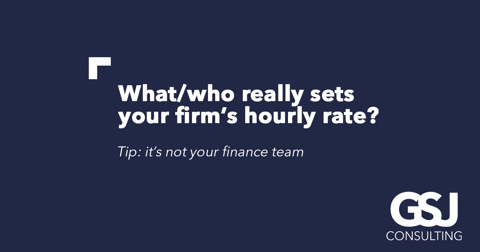Your hourly rate is set by the market, not your finance team!

Every year, as July 1 approaches, just like death and taxes, two events are certain to occur at professional services firms across Australia:
- Revenue targets will be reset to zero; and
- Hourly rates for all professionals in the firm will increase, in some cases by as much as 10-20%.
Finance and executive management teams will be walking the corridors, or calling you into their offices, to let you know they control the firm’s pricing strategy, and this is how much you and your team will be charging in the upcoming financial year.
The hourly rate myth
In the board meeting, the finance team controls pricing. They set the “rack rate” for all professionals over the next 12 months. They do this by building profitability models around the cost of doing business plus a profit margin needed to ensure profit targets are achieved.
But, and it’s a BIG but, there is a problem with this calculation methodology, and that is this: The all-important client is missing from the equation!
The illusion of control
So, let’s start with how hourly rates are typically developed.
Finance and the executive management teams will calculate the cost of delivering professional services, apply a markup for desired profit margins, and issue a schedule of rack rates based on seniority of role.
These rate cards then become the foundation for proposals and bids.
Only they don’t, because most firms will allow for a variation of 10-20% away from rack rates to take into account clients’, competitors’, and the procurement team’s perceived and/or defined (i.e., allocated budget) value for the work.
Thus, while the finance team might provide the framework of how your firm prices its services, the reality is that the market determines the value, and thus, the appropriate price.
If your clients won’t pay your rack rates, those rates are meaningless.
But finance does set the floor limit!
What finance does set is what is known in the industry as the “walk away” price, in that finance is a critical component in setting baseline pricing to protect profitability.
Much like the firm’s in-house General Counsel is there to protect the firm from being sued, the finance team ensures the firm doesn’t make a loss. In both cases, it’s a job well done, but it is not commercial, and therefore not pricing optimisation.
The role procurement plays in setting your hourly rate
One of, if not the biggest, changes in the acquisition of professional services in recent times has been the increased role that procurement plays in the purchasing of professional services.
Sophisticated client procurement teams will:
- benchmark firms against one another;
- require justification of rates in tender processes;
- demand volume discounts, blended rates, or capped fee arrangements for work.
Under this type of pressure, most firms’ standard hourly rack rates become meaningless if they wish to win the work.
The internal devaluing of the billable hour
Leaving to one side the external factors on why your rack rate is an illusion, internal issues also arise.
Most lawyers suffer from imposter syndrome when it comes to their hourly rate and value. This typically leads to one or both of the following:
- They discount their rate by 10% as a default mechanism; and/or
- They don’t bother recording the time at all (because I’m a professional and should have done it quicker).
What can firms learn from this?
Accepting that hourly rates are set by the market prompts a shift in mindset. Your professionals start to understand that the way they can determine price is not set by their billable hours but by:
- Client expectations: Based on what the client expects to pay (unless you communicate why additional value is being delivered).
- Competitive pricing: What your competitors are charging for similar services.
- Perceived value: How clients view your expertise, outcomes and service model. This aspect should not be devalued. Clients often pay for a good service over and above a good outcome/result.
5 steps to take to move your pricing function forward
Here are five things your firm can be doing today to align better with the market realities of today and tomorrow.
- Invest in market intelligence: Understand what competitors are charging, how clients benchmark services and where your firm sits in the value chain. Use these insights to guide pricing strategy.
- Support client-facing teams: Equip partners and BD teams with the tools to have confident pricing conversations, rather than relying on historical rate cards.
- Embrace pricing flexibility: If your firm insists on standardised pricing, regardless of client type, matter complexity, or strategic value, you’ll lose ground. Introduce flexibility that reflects the client’s priorities and competitive pressure.
- Train your teams on value-based selling: Teach your team to shift the conversation from “what’s your hourly rate?” to “what’s the value we deliver?” Get the quantum tight, and clients are far more willing to pay for outcomes over time. Finance can’t lead that discussion - you must.
- Use finance: Finally, yes, use finance to provide the cost analysis and margin targets, while ensuring pricing decisions are made by pricing experts!
Final thoughts
Hourly rates are meaningless: The market decides what you are worth!
Finance can give you a compass, but it’s the client, the competition and your own positioning that ultimately sets the price you can charge.
The most successful firms are those that listen to the market, communicate value effectively and empower their teams to price strategically.
Contact GSJ Consulting
We can help you Aquire, Retain, Grow
The information contained in this article is of general nature and should not be construed as professional advice. If you require further information, advice or assistance for your specific circumstances, please contact us.
